Evaluation of the Effects of Soil Layer Classification in the Common Land Model on Modeled Surface Variables and the Associated Land Surface Soil Moisture Retrieval Model
Abstract
:1. Introduction
2. Method
2.1. CoLM Overview
2.2. SSM Retrieval Model
2.3. Experimental Design
3. Result and Discussion
3.1. Simulated Land Surface Variables with Different Soil Layer Classifications
3.2. Impact of Soil Layer Classification on the SSM Retrieval Model
3.3. SSM Retrieval for Cloud-Free Days
3.4. Validation with Measured Data
4. Conclusions
Acknowledgments
Conflicts of Interest
References
- Gusev, Y.M.; Nasonova, O.N. An experience of modelling heat and water exchange at the land surface on a large river basin scale. J. Hydrol 2000, 233, 1–18. [Google Scholar]
- Acora, V.K. Simulating energy and carbon fluxes over winter wheat using coupled land surface and terrestrial ecosystem models. Agric. For. Meteorol 2003, 118, 21–47. [Google Scholar]
- Gibelin, A.L.; Calvet, J.C.; Viovy, N. Modelling energy and CO2 fluxes with an interactive vegetation land surface model-Evaluation at high and middle latitudes. Agric. For. Meteorol 2008, 148, 1611–1624. [Google Scholar]
- Alton, P.B. From site-level to global simulation: Reconciling carbon, water and energy fluxes over different spatial scales using a process-based ecophysiological land-surface model. Agric. For. Meteorol 2013, 176, 111–124. [Google Scholar]
- Dickinson, R.E.; Shaikh, M.; Bryant, R; Graumlich, L. Interactive canopies for a climate model. J. Clim 1998, 11, 2823–2836. [Google Scholar]
- Shi, M.; Yang, Z.L.; Lawrence, D.M.; Dickinson, R.E.; Subin, Z.M. Spin-up processes in the Community Land Model version 4 with explicit carbon and nitrogen components. Ecol. Model 2013, 263, 308–325. [Google Scholar]
- Leng, P.; Song, X.; Li, Z.-L.; Ma, J.; Zhou, F.; Li, S. Bare surface soil moisture retrieval from the synergistic use of the optical and thermal infrared data. Int. J. Remote Sens. 2013, in press.. [Google Scholar]
- Zhao, W.; Li, Z.-L. Sensitivity study of soil moisture on the temporal evolution of surface temperature over bare surfaces. Int. J. Remote Sens 2013, 34, 3314–3331. [Google Scholar]
- Zhao, W.; Li, Z.-L.; Wu, H.; Tang, B.-H.; Zhang, X.; Song, X.; Zhou, G. Determination of bare surface soil moisture from combined temporal evolution of land surface temperature and net surface shortwave radiation. Hydrol. Process 2013, 27, 2825–2833. [Google Scholar]
- Martinez, J.E.; Duchon, C.E.; Crosson, W.L. Effect of the number of soil layers on a modeled surface water budget. Water Resour. Res 2001, 37, 367–377. [Google Scholar]
- Mahrt, L.; Pan, H. A two-layer model of soil hydrology. Bound. Layer Meteorol 1984, 29, 1–20. [Google Scholar]
- Hughes, D.; Sami, K. A semi-distributed, variable time interval model of catchment hydrology-structure and parameter estimation procedures. J. Hydrol 1994, 155, 265–291. [Google Scholar]
- Liang, X.; Lettenmaier, P.; Wood, E.; Burges, S. A simple hydrologically based model of land surface water and energy fluxes for general circulation models. J. Geophys. Res 1994, 99, 14415–14428. [Google Scholar]
- Lakshmi, V.; Wood, E. Diurnal cycles of evaporation using a two-layer hydrological model. J. Hydrol 1998, 204, 37–51. [Google Scholar]
- Gochis, D.J.; Vivoni, E.R.; Watts, C.J. The impact of soil depth on land surface energy and water fluxes in the North American Monsoon region. J. Arid Environ 2010, 74, 564–571. [Google Scholar]
- Wang, A.; Zeng, X.; Shen, S.; Zeng, Q.; Dickinson, R.E. Timescales of land surface hydrology. J. Hydrometeorol 2006, 7, 868–879. [Google Scholar]
- Meerveld, I.T.; Weiler, W. Hillslope dynamics modeled with increasing complexity. J. Hydrol 2008, 361, 24–40. [Google Scholar]
- Chen, F.; Jimy, D. Coupling an advanced land surface-hydrology model with the Penn State-NCAR MM5 modeling system. Mon. Wea. Rev 2001, 129, 569–585. [Google Scholar]
- Dai, Y.; Ji, D. The Common Land Model (CoLM) User’s Guide. 2005. Available online: http://globalchange.bnu.edu.cn/research/models (accessed on 7 July 2008).
- Zeng, X.; Shaikh, M.; Dai, Y.; Dickinson, R.E.; Myneni, R. Coupling of the common land model to the NCAR community climate model. J. Clim 2002, 15, 1832–1854. [Google Scholar]
- Dai, Y.; Zeng, X.; Dickinson, R.E.; Baker, I.; Bonan, G.; Bosilovich, M.; Denning, A.; Dirmeyer, P.; Houser, P.; Niu, G.; et al. The common land model. Bull. Amer. Meteor. Soc 2003, 8, 1013–1023. [Google Scholar]
- Dickinson, R.E.; Henderson-Sellers, A.; Kennedy, P.J. Biosphere-Atmosphere Transfer Scheme (BATS) Version 1e as Coupled to Community Climate Model; NCAR Technical Note NCAR/TN-387+STR; Climate and Global Dynamics Division (CGD), NCAR: Boulder, CO, USA,. 1993. Available online: http://opensky.library.ucar.edu/collections/TECH-NOTE-000-000-000-198 (accessed on 21 October 2012).
- Bonan, G.B. A Land Surface Model (LSM Version 1.0) for Ecological, Hydrological, and Atmospheric Studies: Technical Description and User’s Guide; NCAR Technical Note NCAR/TN-417+STR; National Center for Atmospheric Research: Boulder, CO, USA, 1996; p. 150. [Google Scholar]
- Dai, Y.; Zeng, Q.-C. A land surface model (IAP94) for climate studies, Part I: Formulation and validation in off-line experiments. Adv. Atmos. Sci 1997, 14, 433–460. [Google Scholar]
- Li, Z.-L.; Tang, R.L.; Wan, Z.; Bi, Y.; Zhou, C.; Tang, B.H.; Yan, G.; Zhang, X. A review of current methodologies for regional evapotranspiration estimation from remotely sensed data. Sensors 2009, 9, 3801–3853. [Google Scholar]
- Li, Z.-L.; Tang, B.H.; Wu, H.; Ren, H.; Yan, G.; Wan, Z. Satellite-derived land surface temperature: Current status and perspectives. Remote Sens. Environ 2013, 131, 14–37. [Google Scholar]
- Song, X.; Leng, P.; Li, X.; Li, X.; Ma, J. Retrieval of daily evolution of soil moisture from satellite-derived land surface temperature and net surface shortwave radiation. Int. J. Remote Sens 2013, 34, 3289–3298. [Google Scholar]
- Pierdicca, N.; Pulvirenti, L.; Bignami, C. Soil moisture estimation over vegetated terrains using multitemporal remote sensing data. Remote Sens. Environ. 2010, 114, 440–448. [Google Scholar]
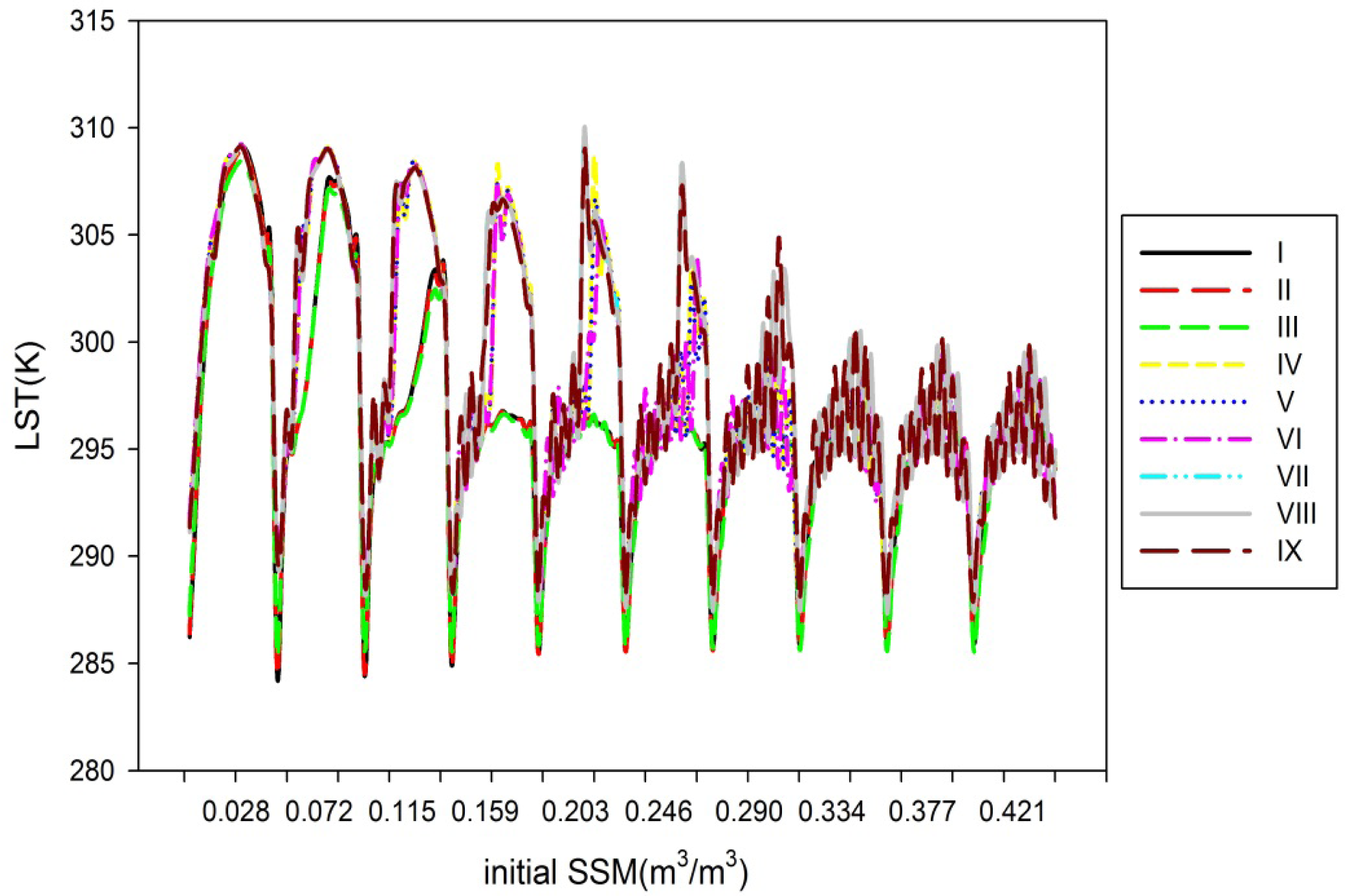
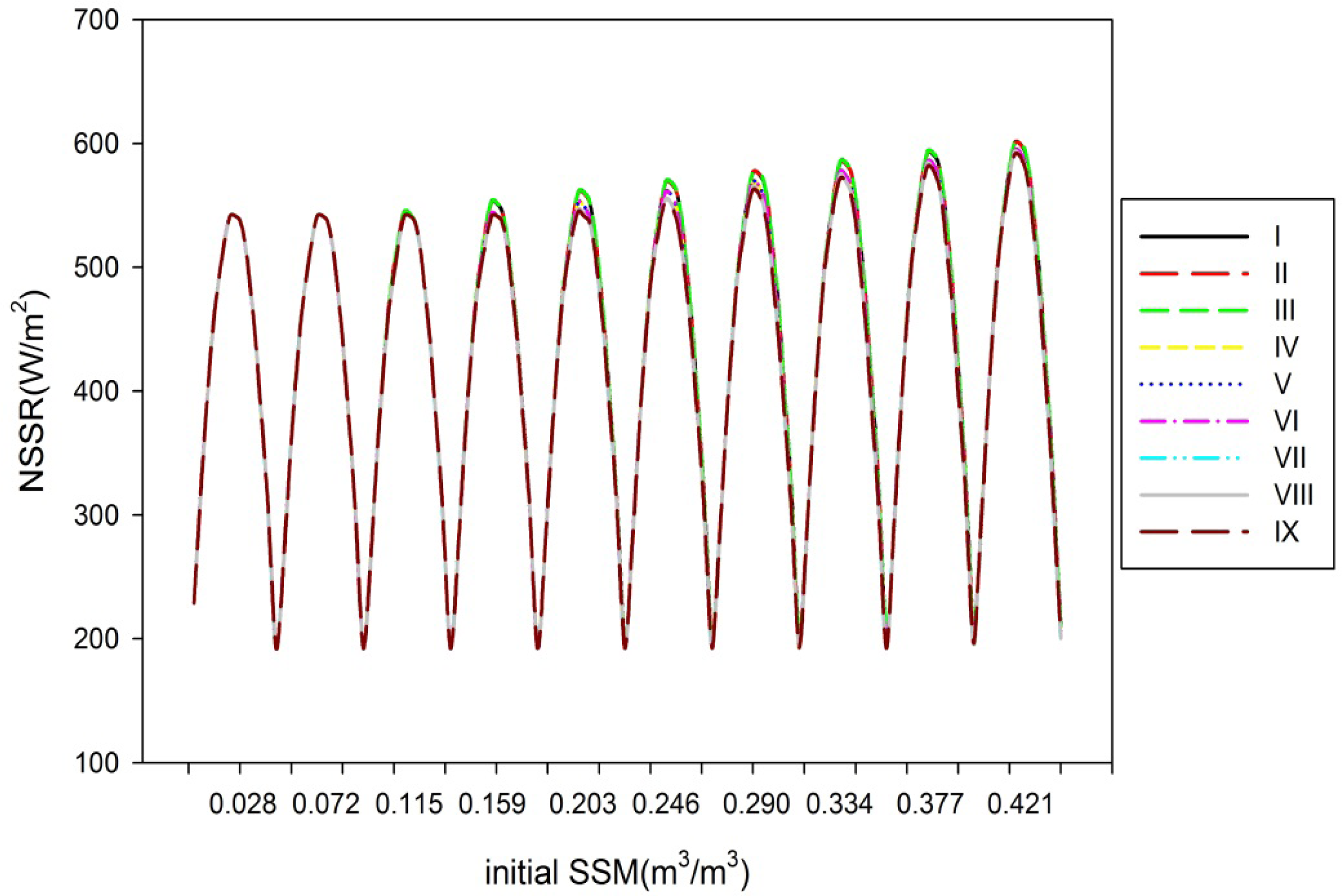
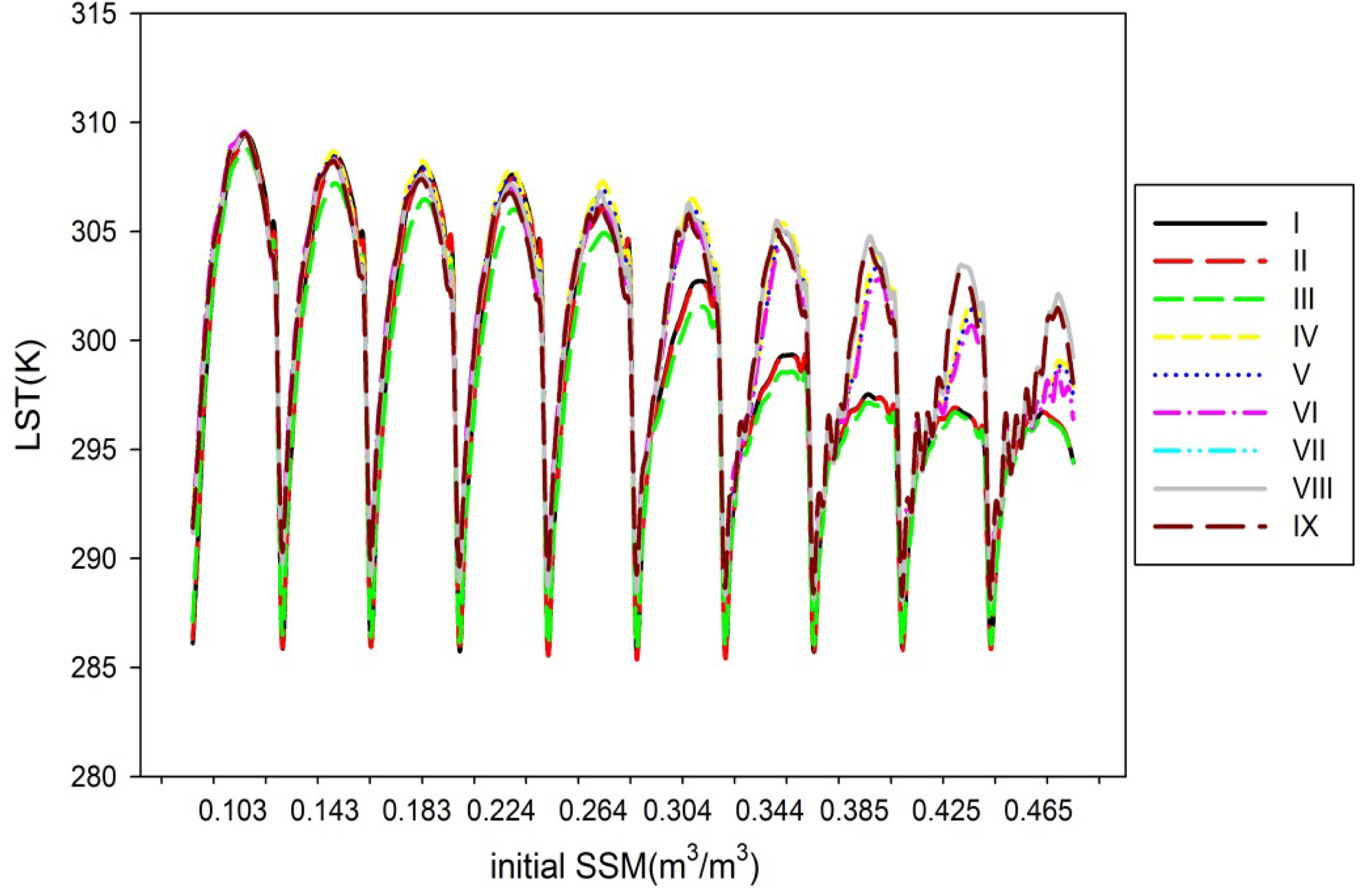


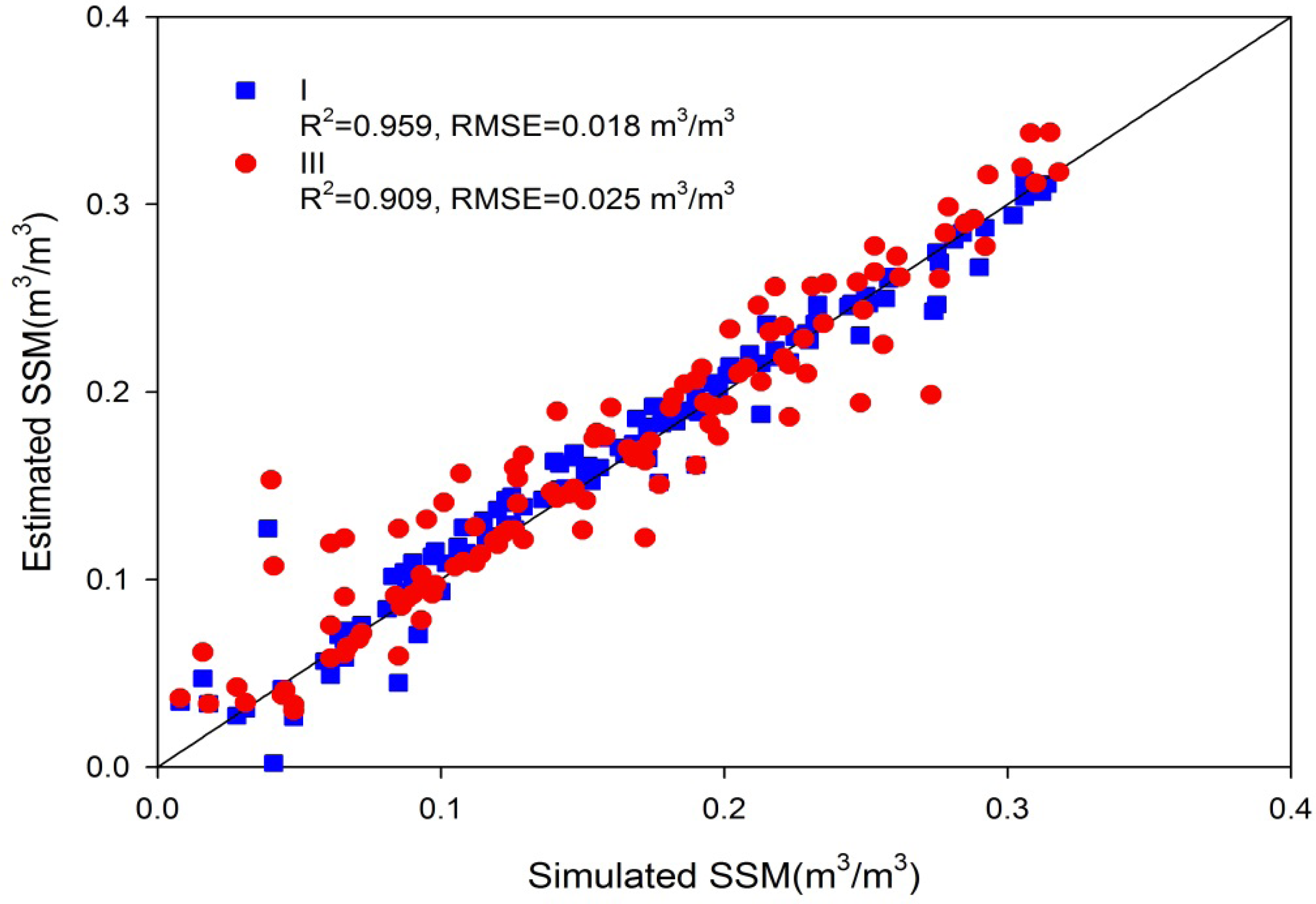
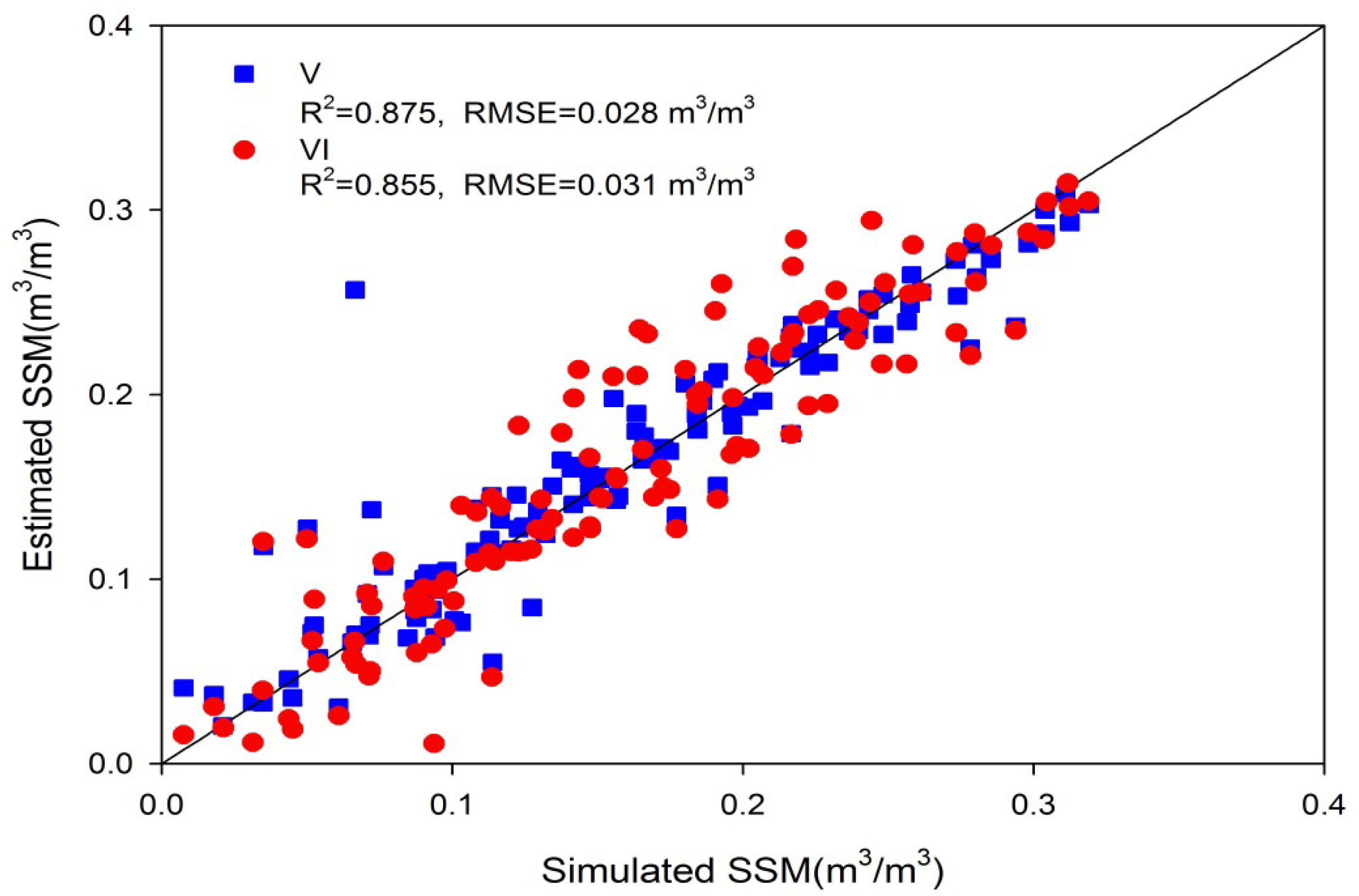
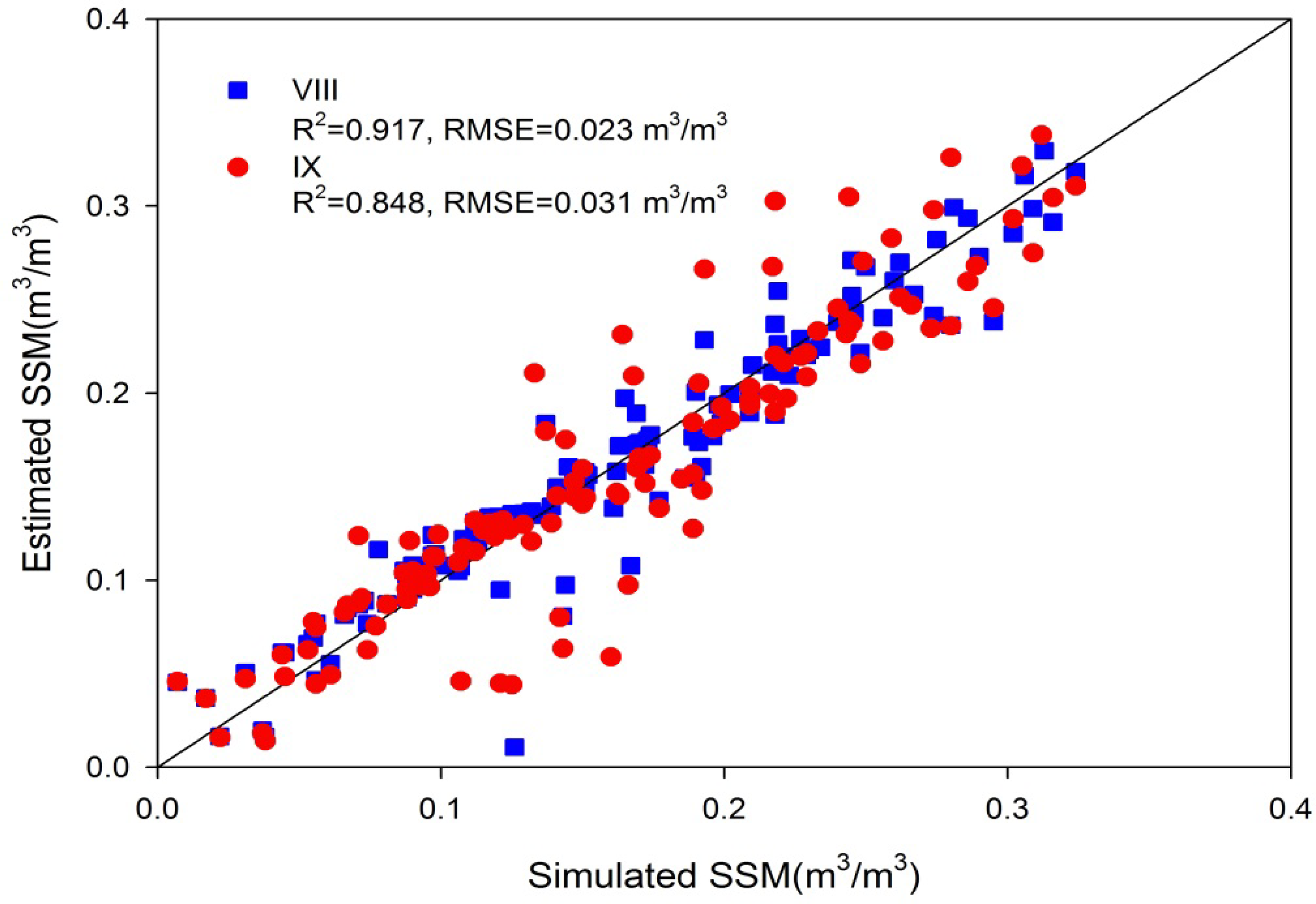
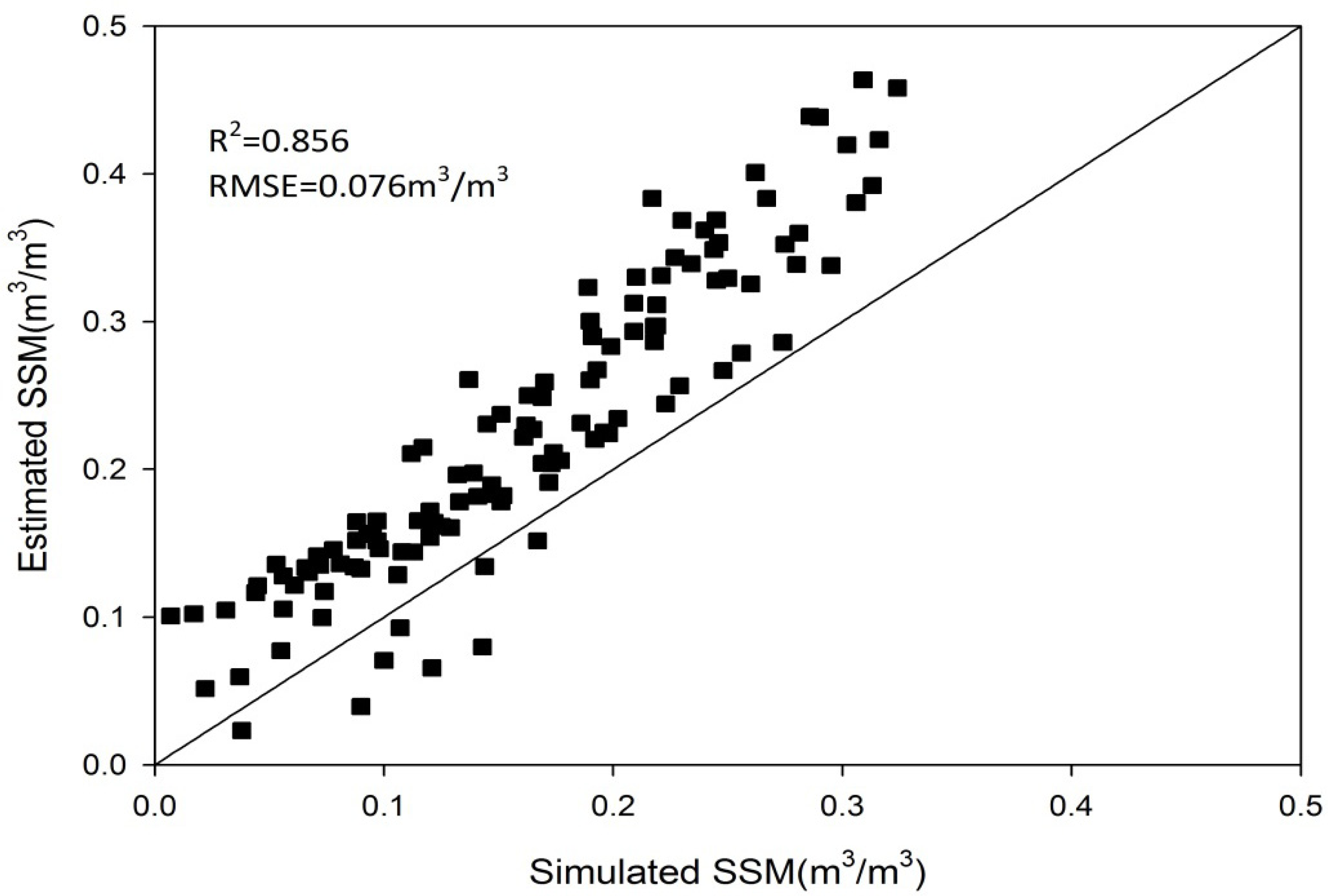

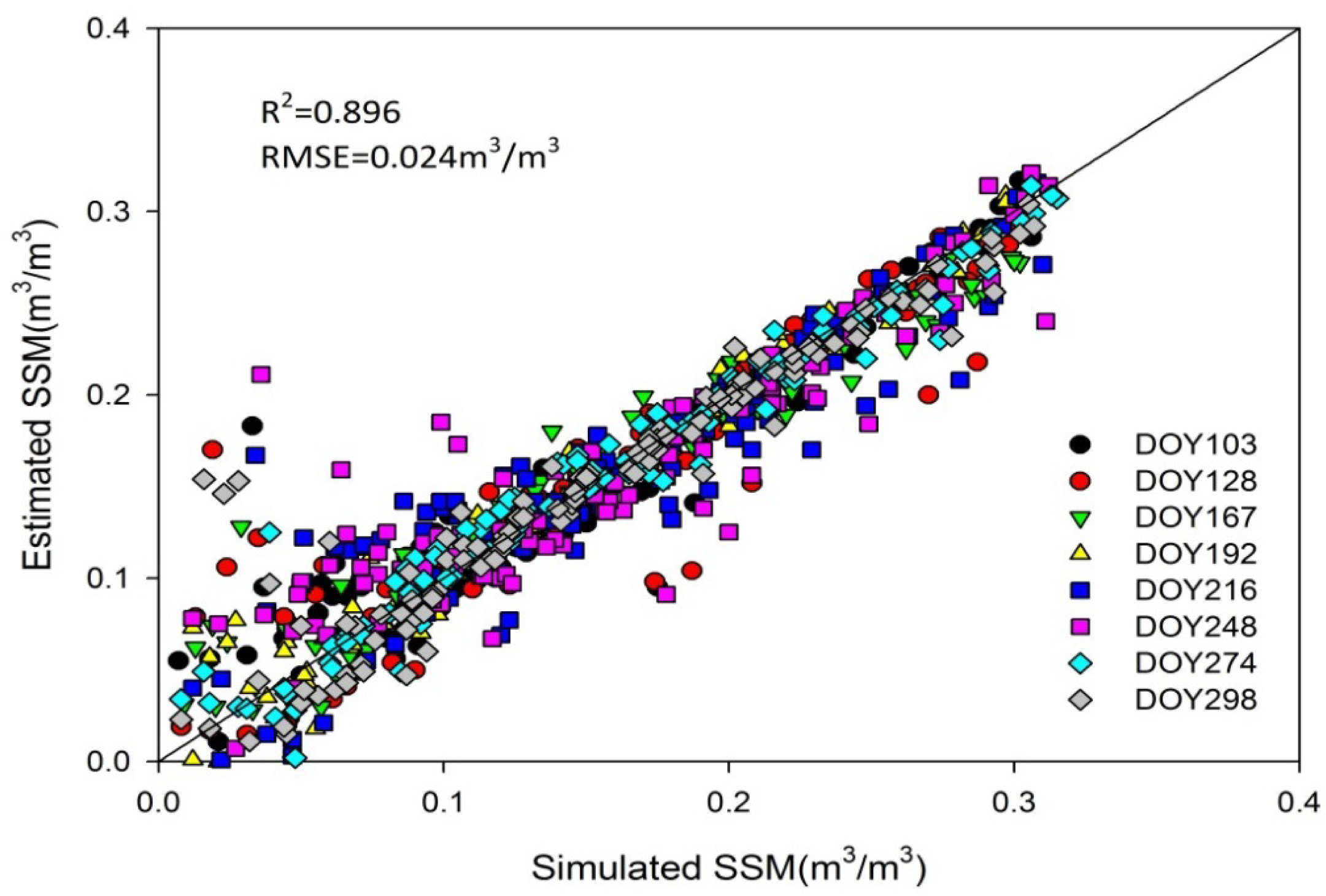
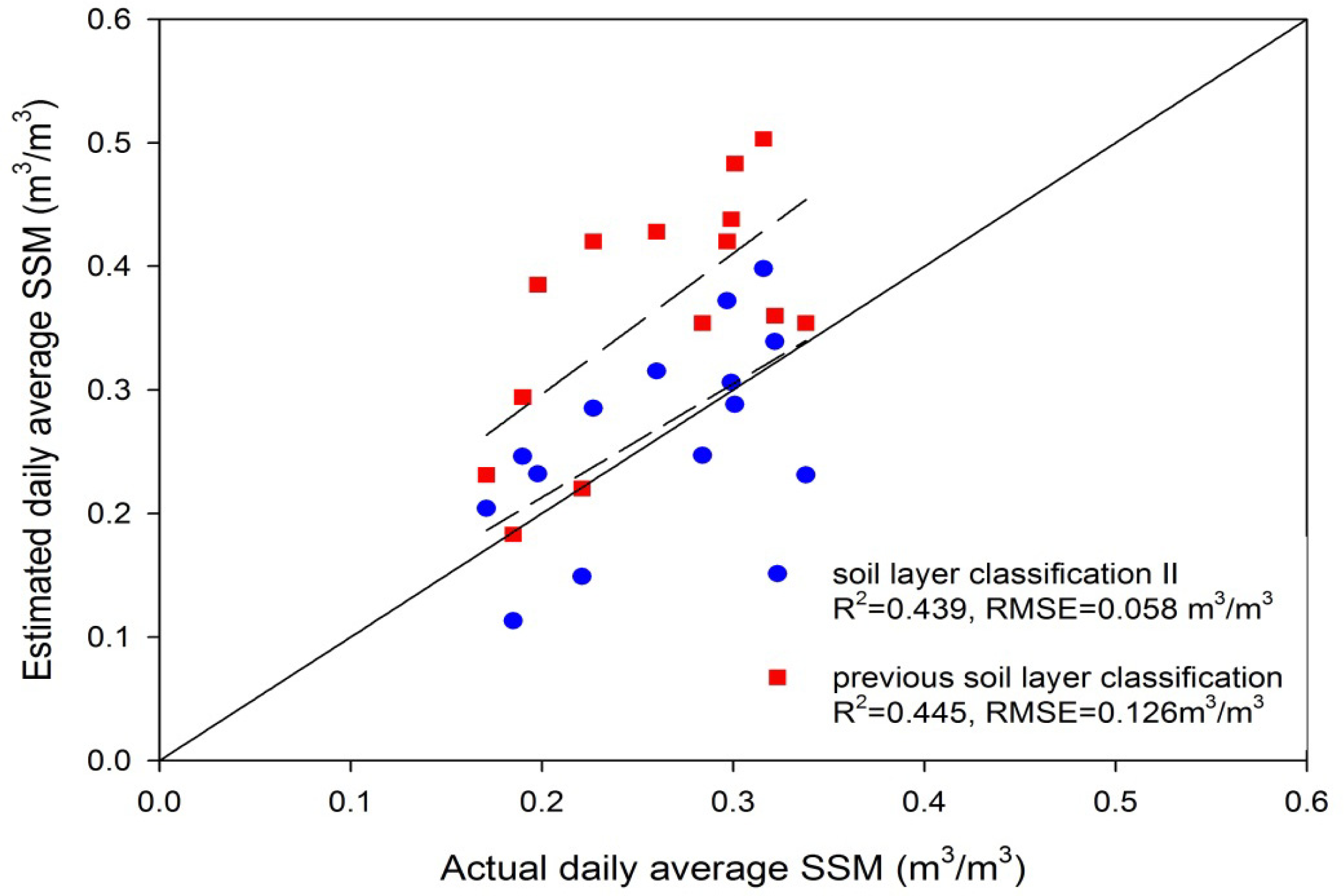
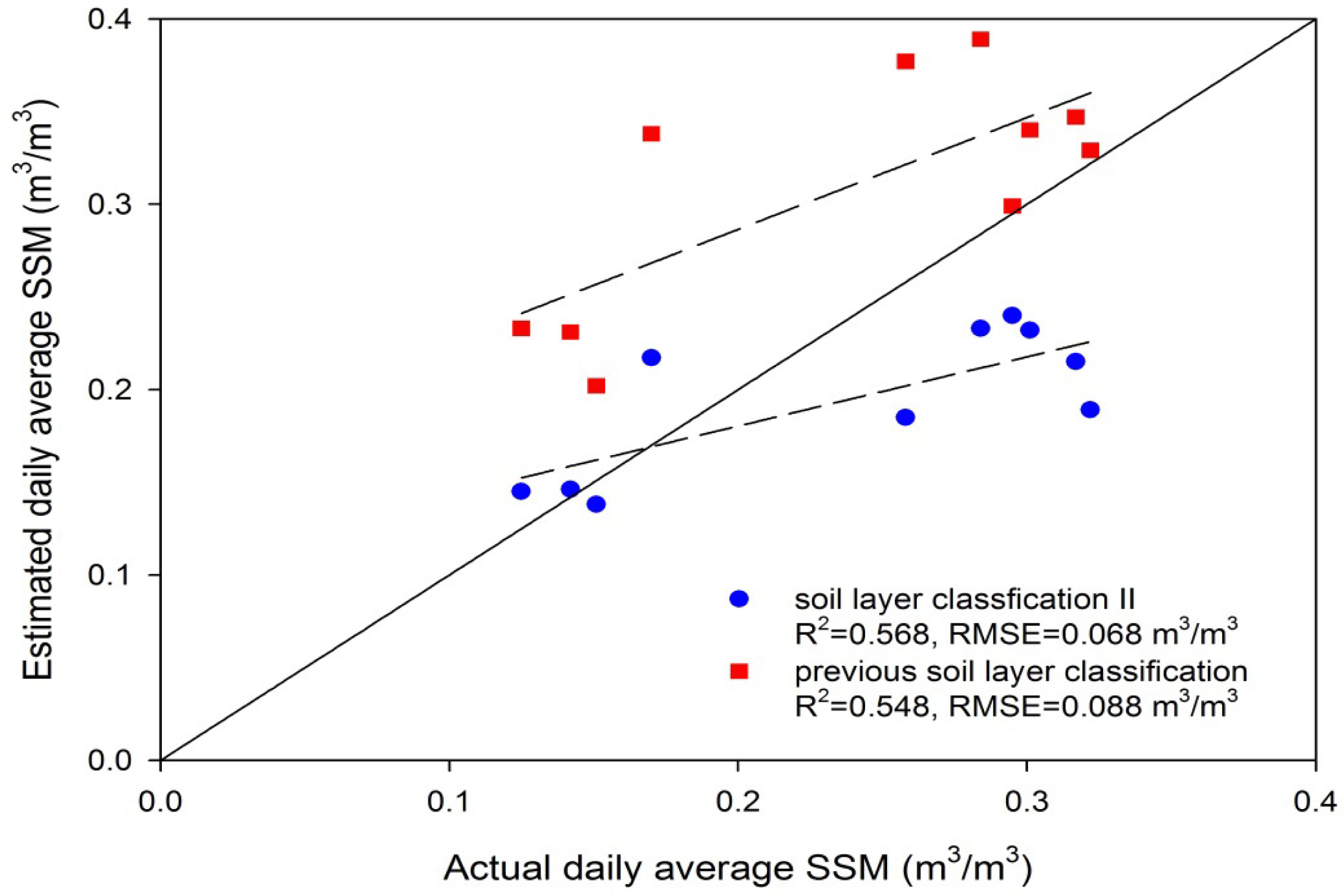
| Layer Index | I | II | III | IV | V | VI | VII | VIII | IX |
|---|---|---|---|---|---|---|---|---|---|
| 1 | 0.05 | 0.05 | 0.05 | 0.01 | 0.01 | 0.01 | 0.01 | 0.01 | 0.01 |
| 2 | 0.10 | 0.10 | 0.10 | 0.05 | 0.05 | 0.05 | 0.03 | 0.03 | 0.03 |
| 3 | 0.15 | 0.20 | 0.40 | 0.10 | 0.10 | 0.10 | 0.05 | 0.05 | 0.05 |
| 4 | 0.20 | 0.40 | 0.80 | 0.20 | 0.30 | 0.60 | 0.10 | 0.10 | 0.10 |
| 5 | 0.40 | 0.60 | 1.30 | 0.40 | 0.60 | 1.30 | 0.40 | 0.40 | 1.30 |
| 6 | 0.60 | 1.00 | 1.50 | 0.60 | 1.00 | 1.50 | 0.60 | 0.80 | 1.50 |
| 7 | 0.80 | 1.30 | 1.80 | 0.80 | 1.30 | 1.80 | 0.80 | 1.30 | 1.80 |
| 8 | 1.00 | 1.50 | 2.00 | 1.00 | 1.50 | 2.00 | 1.00 | 1.50 | 2.00 |
| 9 | 1.30 | 2.00 | 2.20 | 1.30 | 2.00 | 2.20 | 1.30 | 2.00 | 2.20 |
| 10 | 2.50 | 2.50 | 2.50 | 2.50 | 2.50 | 2.50 | 2.50 | 2.50 | 2.50 |
| No. | Sand (%) | Silt (%) | Clay (%) | Soil Types | Range of SSM (m3/m3) |
|---|---|---|---|---|---|
| 1 | 92 | 5 | 3 | Sand | 0.010–0.339 |
| 2 | 82 | 12 | 6 | Loamy Sand | 0.028–0.421 |
| 3 | 58 | 32 | 10 | Sandy Loam | 0.047–0.434 |
| 4 | 17 | 70 | 13 | Silt Loam | 0.084–0.476 |
| 5 | 10 | 85 | 5 | Silt | 0.084–0.476 |
| 6 | 43 | 39 | 18 | Loam | 0.066–0.439 |
| 7 | 58 | 15 | 27 | Sandy Clay Loam | 0.067–0.404 |
| 8 | 10 | 56 | 34 | Silty Clay Loam | 0.120–0.464 |
| 9 | 32 | 34 | 34 | Clay Loam | 0.103–0.465 |
| 10 | 52 | 6 | 42 | Sandy Clay | 0.100–0.406 |
| 11 | 6 | 47 | 47 | Silty Clay | 0.126–0.468 |
| 12 | 22 | 20 | 58 | Clay | 0.138–0.468 |
| DOY | Maximal Solar Radiation (W/m2) | Average Wind Speed (m/s) | Average Air Temperature (K) |
|---|---|---|---|
| 103 | 864 | 4.05 | 287.68 |
| 128 | 906 | 3.05 | 297.25 |
| 167 | 918 | 3.02 | 303.85 |
| 192 | 1035 | 3.46 | 298.95 |
| 216 | 968 | 3.20 | 302.25 |
| 248 | 885 | 2.92 | 302.65 |
| 274 | 774 | 2.59 | 298.75 |
| 298 | 694 | 15.50 | 281.39 |
| No. | n1 | n2 | n3 | n4 | n0 | R2 | RMSE (m3/m3) |
|---|---|---|---|---|---|---|---|
| I | 1.289 | 3.161 | 3.104 | 0.923 | −2.816 | 0.951 | 0.018 |
| II | 1.192 | 3.224 | 3.114 | 0.920 | −2.793 | 0.953 | 0.017 |
| III | 0.762 | 3.586 | 3.264 | 0.823 | −2.672 | 0.956 | 0.017 |
| IV | −0.416 | 3.434 | 2.620 | 0.454 | −1.663 | 0.899 | 0.025 |
| V | −0.356 | 3.119 | 2.505 | 0.489 | −1.621 | 0.888 | 0.027 |
| VI | −0.348 | 3.192 | 2.590 | 0.433 | −1.606 | 0.879 | 0.028 |
| VII | −0.422 | 3.655 | 2.715 | 0.424 | −1.704 | 0.917 | 0.023 |
| VIII | −0.419 | 3.648 | 2.711 | 0.426 | −1.704 | 0.917 | 0.023 |
| IX | −0.358 | 3.046 | 2.286 | 0.410 | −1.449 | 0.850 | 0.031 |
© 2013 by the authors; licensee MDPI, Basel, Switzerland This article is an open access article distributed under the terms and conditions of the Creative Commons Attribution license ( http://creativecommons.org/licenses/by/3.0/).
Share and Cite
Leng, P.; Song, X.; Li, Z.-L.; Wang, Y. Evaluation of the Effects of Soil Layer Classification in the Common Land Model on Modeled Surface Variables and the Associated Land Surface Soil Moisture Retrieval Model. Remote Sens. 2013, 5, 5514-5529. https://doi.org/10.3390/rs5115514
Leng P, Song X, Li Z-L, Wang Y. Evaluation of the Effects of Soil Layer Classification in the Common Land Model on Modeled Surface Variables and the Associated Land Surface Soil Moisture Retrieval Model. Remote Sensing. 2013; 5(11):5514-5529. https://doi.org/10.3390/rs5115514
Chicago/Turabian StyleLeng, Pei, Xiaoning Song, Zhao-Liang Li, and Yawei Wang. 2013. "Evaluation of the Effects of Soil Layer Classification in the Common Land Model on Modeled Surface Variables and the Associated Land Surface Soil Moisture Retrieval Model" Remote Sensing 5, no. 11: 5514-5529. https://doi.org/10.3390/rs5115514




